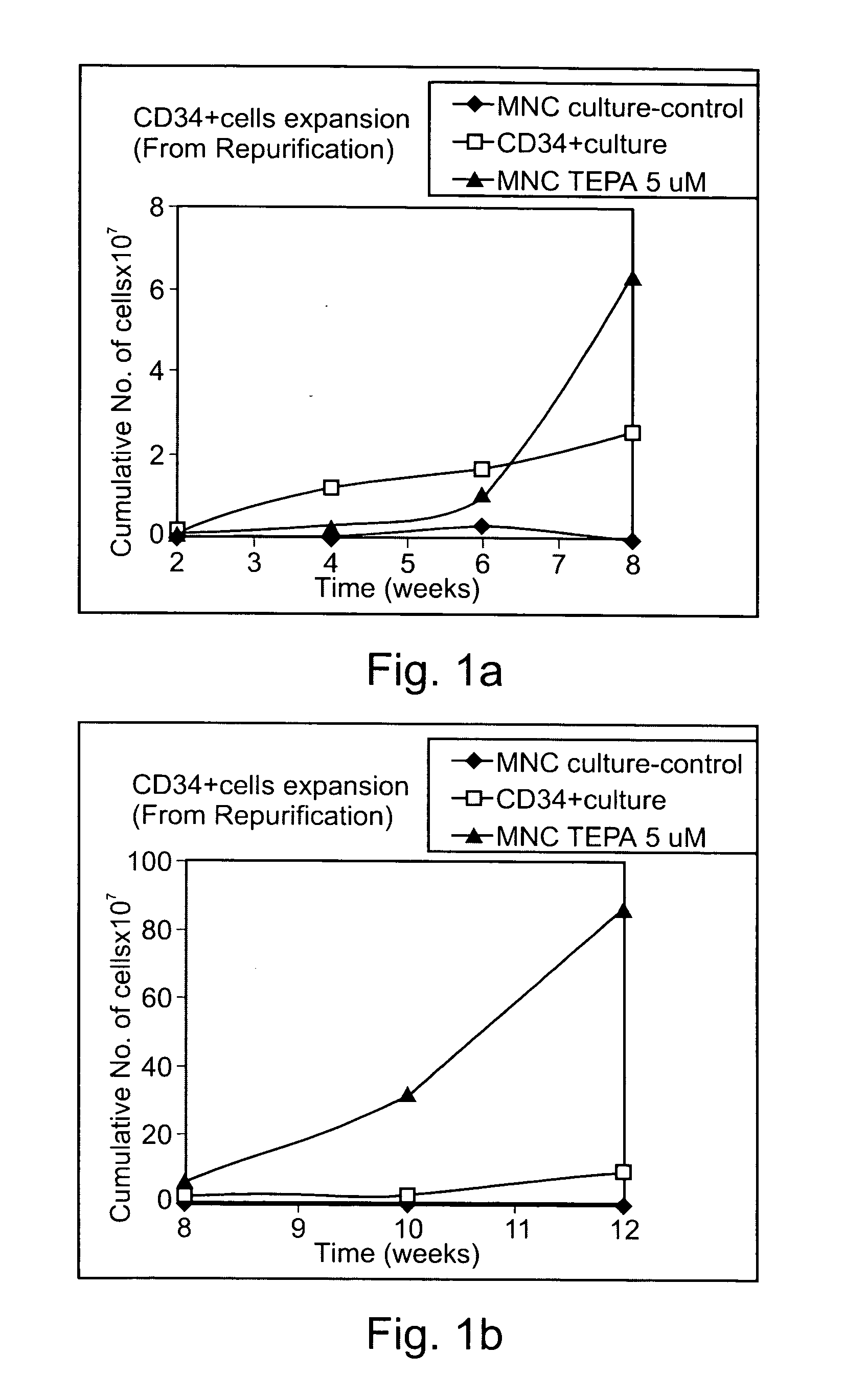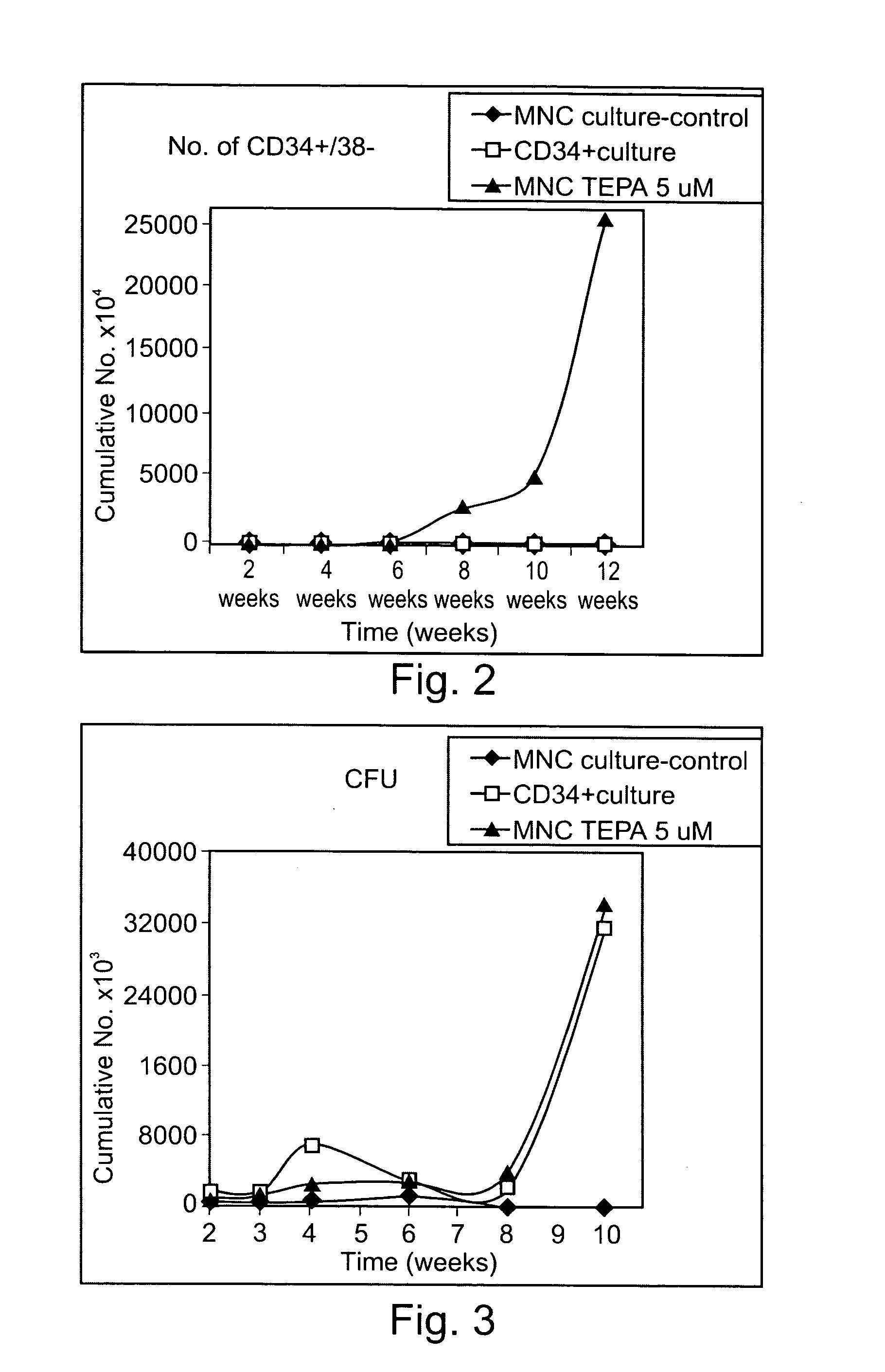EX-VIVO expansion of hematopoietic system cell populations in mononuclear cell cultures
- Summary
- Abstract
- Description
- Claims
- Application Information
AI Technical Summary
Benefits of technology
Problems solved by technology
Method used
Image
Examples
example 1
The Effect of a Copper Chelator on the Ex-Vivo Expansion of Hema Topoietic Stem Cells of a Mononuclear Cells Culture
Experimental Procedures
Sample collection and processing: Samples were obtained from umbilical cord blood after a normal full-term delivery and were frozen within 24 hours pospartum. The blood cells were thawed in Dextran buffer and incubated for 15 hours in MEM (Biological Industries, Israel) supplemented with 10% fetal calf serum (FCS; Biological Industries). The cells were then layered on Ficoll-Hypaque (density 1.077 gram / ml; Sigma) and centrifuged at 400 g for 30 minutes at room temperature. The mononuclear cells in the interface layer were then collected, washed three times in phosphate-buffered saline (PBS; Biological Industries), and re-suspended in PBS containing 0.5% human serum albumin (HSA). The cells were then split into two fractions, the first being the mononuclear cells (MNC) fraction and the second fraction was used for purifying CD34+ cells by immun...
example 2
The Effect of a Copper Chelate on the Ex-Vivo Expansion of Hema Topoietic Stem Cells of a Mononuclear Cells Culture
Copper-TEPA chelate was prepared as described, for example, in PCT / IL03 / 00062.
Mononuclear cells (MNC) were seeded in culture bags and were provided with nutrients and cytokines as described in Example 1 above. The mononuclear cell cultures were either untreated (control) or treated with Cu-TEPA chelate. The treated MNC cultures were supplemented with Copper-TEPA chelate for the first three weeks and from week three onward were topped with chelator-free media. All cultures were analyzed eight weeks after an 8-week period.
The results, presented in Table 1 below, show that addition of Copper-TEPA chelate to MNC cultures markedly increased the number of CD34+ cells, the proportion of CD34+ cells, and the number of CD34+CD38− cells, after an eight weeks incubation period. Thus, the cumulative number of CD34+ cells per culture bag after incubation was 2.56×106, 12.37×10...
example 3
The Effect of a RAR Antagonist on the Ex-Vivo Expansion of Hema Topoietic Stem Cells of a Mononuclear Cells Culture
Materials and Experimental Methods
The high-Affinity retinoic acid receptor (RAR) antagonist 4-[[4-(4-ethylphenyl)-2,2-dimethyl-(2H)-thiochomen-6-yl)]-benzoic acid, (AGN 194310) was synthesized according to the procedure described in PCT / IL03 / 00064.
Mononuclear cells fraction was collected and purified as described above in Example 1. MNC cultures were prepared and maintained as described above. AGN 194310 RAR antagonist was added to the tested cultures at concentrations ranging from 1×10−3-1×10−11 M [or 410 μg / l to 4.1×10−5 μg / l]. The antagonist was added for a predetermined, limited period, for up to three weeks or continuously during the entire culture period.
The results, presented in Table 2, show that mononuclear cell fractions cultured in the presence of RAR antagonists and cytokines revealed a significant increase in the number of CD34+Lin− cells (78%, 24%) ...
PUM
| Property | Measurement | Unit |
|---|---|---|
| Fraction | aaaaa | aaaaa |
| Cell proliferation rate | aaaaa | aaaaa |
| Degradation properties | aaaaa | aaaaa |
Abstract
Description
Claims
Application Information
 Login to View More
Login to View More - R&D
- Intellectual Property
- Life Sciences
- Materials
- Tech Scout
- Unparalleled Data Quality
- Higher Quality Content
- 60% Fewer Hallucinations
Browse by: Latest US Patents, China's latest patents, Technical Efficacy Thesaurus, Application Domain, Technology Topic, Popular Technical Reports.
© 2025 PatSnap. All rights reserved.Legal|Privacy policy|Modern Slavery Act Transparency Statement|Sitemap|About US| Contact US: help@patsnap.com



